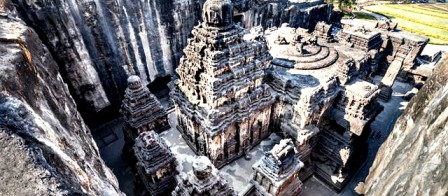Ashoka’s Edicts and Inscriptions- History Study Notes & Stuff
Ashoka's Edicts and Inscriptions
Ashoka's edicts are in a total of 33 inscriptions present on the pillar, boulders and cave walls of the Mauryan period, during the reign of Emperor Ashoka, which is spread across the Indian sub-continent covering India, Pakistan and Nepal.
Ashoka inscriptions are divided into three broad sections -
1. Major Rock edicts
2. Pillar rock edicts
3. Minor rock edicts
These edicts of ashoka mention that Buddhism as a religion reached the Mediterranean Sea during the reign of Ashoka. Many Buddhist monuments were built over a wide area. In these Ashoka's Edicts, Buddhism and Buddha are also mentioned. But mainly these edicts focus more on social and moral precepts rather than on the religious practices (or philosophical dimensions) of Buddhism during the reign of Ashoka
Main thing in these inscriptions is, that Ashoka refers to himself in many of these inscriptions as “Devanampiya” which means “Beloved of the Gods” and “Kings Piyadasi.”
Ashoka inscription language:
The inscriptions found in the eastern parts (of the Maurya Empire) are written using the Brahmi script in the Magadhi language. Whereas in the western parts of the empire, the script used is Kharosthi, written in Prakrit. An extract in Edict 13 is written in Greek and Aramaic to add to the variety.
The world came to know of these description of the Mauryan Empire when Ashoka's edicts and Ashoka inscriptions were decoded by the British archaeologist James Prinsep.
Major Rock Edicts of Ashoka:
There are 14 major rock edicts of Ashoka in series and two are separate.
Major Rock Edict I:
It bans animal slaughter and bans festive celebrations. He mentioned that only two peacocks and a deer were being killed in Ashoka's kitchen which he wanted to shut down.
Major Rock Edit II -
This edict was provided for the care of humans and animals. It also describes the presence of the Pandyas , Satyapura and Keralaputra state of South India.
Major Rock edict III :
It mentions and guides the generosity towards Brahmins. This edict was released 12 years after Ashoka's coronation. It tells of Yukta who was a subordinate officer and Rajuk along with the Pradesikas used to go to all parts of the state every five years for the spread of Ashoka's Dhamma policy.
Major Rock Edit IV:
It states that Dhammaghosa (voice of righteousness) is the norm for mankind and not Bherighosa (voice of war). It also show about the impact of Dhamma on society.
Major Rock Edit V:
It worries about people's policy towards their slaves. The "Dhamma Mahamatras" are mentioned in this edict as members of the state.
Major Rock Edict VI:
It describes the king's desire to be constantly informed about the conditions of the people of his rule and Welfare measures for people.
Major Rock Edit VII:
requests tolerance for all sects and religions. This is repeated on 12th edict.
Major Rock Edict VIII:
It describes Ashoka's first Dhamma visit (yatra) to BodhGaya and Bodhi Tree.
Major Rock Edict IX:
This edict of ashoka condemns popular ceremonies and Emphasis on dhamma.
Major Rock Edict X:
It condemns the person's desire for fame and glory and Dhamma's popularity was emphasized.
Major Rock Edict XI:
It elaborates Dhamma(Moral Law's).
Major Rock Edict XII:
Here he appealed for tolerance between various sects and religions , as described in the 7th edict.
Major Rock Edition XIII:
In this Ashoka mentioned his victory over Kalinga and also mentioned Victory of Ashoka's Dhamma among the Greek kings, Antiochus of Syria, Ptolemy of Egypt, Antigonus of Macedonia, Magas of Siren, Alexander of Epirus and Chola, Pandya, etc.
Major Rock Edict XIV:
It describes engraving inscriptions in different parts of the country.
Pillar Edicts of Ashoka:
The pillar edits of ashoka use two types of stones. One type is a speckled, white sandstone that comes from Mathura. Another type is a buff colored sandstone and quartzite that comes from Amravati. A total of 11 pillars of ashoka have been found from India and Nepal. They are found in Topra (Delhi), Meerut, Kaushambi, Rampurwa, Champaran, Mehrauli, Sanchi, Sarnath, Rummindei and Nigalisagar. All these pillars are monolithic (made of single rock).
Pillar Edict I:
It mentions ashoka's principles to protect people
Pillar Edict II:
It defines ‘dhamma’.
Pillar Edict III:
It eliminates harshness, cruelty, pride, anger among its subjects in the form of sins.
Pillar Editing IV:
It mentions deals with duties of Rajukas.
Pillar Edict V:
This edict mentioned animals and birds list which shall not be killed on listed days. Also there is another animals list that should not be killed at all occasions.
Pillar Edict VI:
It describes the "Dhamma policy"
Pillar Edict VII:
It describes the works done by Ashoka for Dhamma Policy. He observes that all sects desire self control and purity of mind.
Minor Rock Edicts:
They are carved on 15 rocks found throughout India. Minor rock edicts have been found at different locations. Interestingly, Ashoka has used only his name at these four places- Brahmagiri in Karnataka; Maski in Karnataka; at Nettur in Andhra Pradesh; at Gujarra in Madhya Pradesh.
Ashoka's edicts notes will help you in remembering the Edicts of ashoka, 14 major rock of edicts of ashoka, pillar edicts of ashoka, minor rock edicts.
If you want us to add any more details to this article, please do let us know in the comments below.










0 Comments